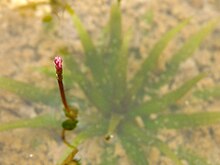Blyxa echinosperma


Taxonavigation
edit| Taxonavigation: Alismatales |
|---|
| Classification System: APG IV
Superregnum: Eukaryota |
Familia: Hydrocharitaceae
Genus: Blyxa
Species: Blyxa echinosperma
Name
editBlyxa echinosperma (C.B.Clarke) Hook.f.
Synonyms
edit- Basionym
- Hydrotrophus echinospermus C.B.Clarke, J. Linn. Soc., Bot. 14: 8 (1873).
- Homotypic
- Blyxa aubertii var. echinosperma (C.B.Clarke) C.D.K.Cook & Luond, Aquatic Bot. 15: 14 (1983).
- Heterotypic
- Blyxa lancifolia Hook.f., Fl. Brit. India 5: 661 (1888).
- Blyxa talbotii Hook.f., Fl. Brit. India 5: 661 (1888).
- Blyxa ceratosperma Maxim. in H.G.A.Engler & K.A.E.Prantl, Nat. Pflanzenfam. 2(1): 253 (1889).
- Blyxa delavayi Gagnep., Bull. Soc. Bot. France 54: 538 (1907).
- Blyxa shimadae Hayata, Icon. Pl. Formosan. 5: 209 (1915).
- Blyxa somae Hayata, Icon. Pl. Formosan. 5: 210 (1915).
- Blyxa echinospermoides Blatt., J. & Proc. Asiat. Soc. Bengal 26: 354 (1930 publ. 1931).
- Blyxa bicaudata Nakai, J. Jap. Bot. 19: 249 (1943).
Distribution
edit| Native distribution areas: |
|---|
References: Brummitt, R.K. 2001. TDWG – World Geographical Scheme for Recording Plant Distributions, 2nd Edition |
References
editPrimary references
edit- Hooker, J.D., assisted by various botanists, 1886–1890. The Flora of British India, Vol. 5. Chenopodiaceae to Orchideae. 910 pp. London: L. Reeve. BHL Reference page. : 5: 661
Additional references
edit- Hara, H., Stearn, W.T. & Williams, H.J. (1978). An Enumeration of the Flowering Plants of Nepal 1: 1-154. Trustees of British Museum, London.
- Lee, W.T. (1996). Lineamenta Florae Koreae: 1-1688. Soul T'ukpyolsi: Ak'ademi Sojok.
Links
edit- Govaerts, R. et al. 2021. Blyxa echinosperma in Kew Science Plants of the World Online. The Board of Trustees of the Royal Botanic Gardens, Kew. Published online. Accessed: 2021 Oct 22. Reference page.
- International Plant Names Index. 2021. Blyxa echinosperma. Published online. Accessed: Oct 22 2021.
- Tropicos.org 2021. Blyxa echinosperma. Missouri Botanical Garden. Published online. Accessed: 22 Oct 2021.
- Hassler, M. 2021. Blyxa echinosperma. World Plants: Synonymic Checklists of the Vascular Plants of the World In: Roskovh, Y., Abucay, L., Orrell, T., Nicolson, D., Bailly, N., Kirk, P., Bourgoin, T., DeWalt, R.E., Decock, W., De Wever, A., Nieukerken, E. van, Zarucchi, J. & Penev, L., eds. 2021. Species 2000 & ITIS Catalogue of Life. Published online. Accessed: 2021 Oct 22. Reference page.
Vernacular names
editالعربية: بليكسة شوكية البذور ç
日本語: スブタ
русский: Бликса колючесемянная
日本語: スブタ
русский: Бликса колючесемянная
| For more multimedia, look at Blyxa echinosperma on Wikimedia Commons. |